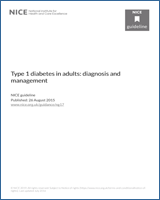NCBI Bookshelf. A service of the National Library of Medicine, National Institutes of Health.
National Clinical Guideline Centre (UK). Type 1 Diabetes in Adults: Diagnosis and Management. London: National Institute for Health and Care Excellence (NICE); 2015 Aug. (NICE Guideline, No. 17.)
July 2016: Recommendation 138 has been reworded to clarify the role of GPs in referring people for eye screening and also to add information on when this should happen.
13.1. Introduction
This chapter was a section of the ‘Management of Late Complications’ chapter in the 2004 guideline CG15. It has been moved to a separate chapter to separate associated illnesses from complications. The 2015 GDG did not update associated illness; 2004 evidence is reproduced verbatim in this chapter.
13.2. Rationale [2004]
Type 1 diabetes is an auto-immune disease associated with genes which modulate the immune response. Other auto-immune diseases are similarly associated, and manifestation of some of them can be sub-clinical while interacting with aspects of food absorption or metabolism. The evidence for routine screening for thyroid dysfunction was reviewed in 2015; recommendations concerning screening for other autoimmune conditions (Addison's disease, pernicious anaemia, premature ovarian failure) has not been reviewed or updated from 2004.
13.3. Evidence statements [2004]
Latent pernicious anaemia
Using a microbiological method to measure cobalamin concentration, one study from Australia found reduced cobalamin concentration in six out of 371 people with type 1 diabetes.168,170 Four of the patients showed no clinical signs of pernicious anaemia, the fifth was mildly anaemic and the sixth patient was not available for further testing. This medium-sized study with methodological limitations gave a prevalence of latent pernicious anaemia of 11 per 1000 in people with type 1 diabetes (III).
Prevalence of coeliac disease
Using immunoglobulin A (IgA) class anti-endomysial antibodies (EmAb) detected by immunofluorescence (test) and histological confirmation of coeliac disease by small intestinal biopsy partial or total villous atrophy, a medium-sized study showed in an unselected sample at an outpatients clinic that the prevalence of coeliac disease in the sampled population was 6.4% and that EmA were highly predictive of the presence of coeliac disease on biopsy (DS).711
A larger study, but with potential methodological limitations, found that in a two-step screening process of anti-gliadin antibodies (GA) detected by enzyme-linked immunosorbent assay (ELISA) assay and IgA class EmAb detected by immunofluorescence, the predictive value of GA was moderate, with a high false-positive rate for IgA-GA.686,687 Prevalence of coeliac disease in type 1 diabetes to be up to 2.6% and that after 30 years diabetes duration, the prevalence of coeliac disease was >6%. The study also found that EmAb were highly predictive of the presence of coeliac disease on biopsy (DS).
The frequency of coeliac disease-specific serologic markers and the prevalence of coeliac disease in families of patients with type 1 diabetes were evaluated in a medium-sized study using a two-step screening process.486 The screening programme included circulating islet cell antibodies (ICA), anti-glutamic acid decarboxylase antibodies and GA, and then IgA class EmAb detected by immunofluorescence. This study found the prevalence of biopsy-proven coeliac disease to be 1.3% among patients with type 1 diabetes and zero among controls, or family. Of screening assays, only EmAb were highly predictive of the presence of coeliac disease (DS).
Another diagnostic study using IgA class EmAb compared people with type 1 diabetes with adults with coeliac disease as true positives (as determined by intestinal biopsy) and controls (healthy and diseased) as true negatives (as determined by intestinal biopsy).649 The prevalence of biopsy-proven coeliac disease among adults with type 1 diabetes was 3.13%. This study showed IgA class EmAb had high specificity in detecting coeliac disease in people with type 1 diabetes (DS).
Red cell distribution width
Using red cell distribution width (RDW) as a screening test against EmAb and diagnostic duodenal biopsy as reference tests for coeliac disease one very small, methodologically-limited study demonstrated the poor specificity of RDW in predicting coeliac disease in people with type 1 diabetes.375,376 Given the potential methodological limitations, this evidence was not used to support any recommendations in this area (DS).
13.4. Health economic evidence [2004]
The health economic searches found no relevant papers for the treatment of those with type 1 diabetes suffering from concurrent disease.
13.5. Considerations [2004]
While auto-immune conditions are probably more common in people with type 1 diabetes than in the general population, the group did not feel that this should lead to any formal system of surveillance for the development of such conditions.
13.6. Recommendations
- 112.
In adults with type 1 diabetes who have a low BMI or unexplained weight loss, assess markers of coeliac disease. For guidance on testing for coeliac disease, see the NICE guideline on coeliac diseaseh. [2004, amended 2015]
- 113.
Be alert to the possibility of the development of other autoimmune disease in adults with type 1 diabetes (including Addison's disease and pernicious anaemia). For advice on monitoring for thyroid disease, see recommendation 177. [2004, amended 2015]
Footnotes
- h
Publication expected September 2015
- Associated illness [2004] - Type 1 Diabetes in Adults: Diagnosis and ManagementAssociated illness [2004] - Type 1 Diabetes in Adults: Diagnosis and Management
Your browsing activity is empty.
Activity recording is turned off.
See more...

